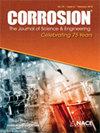两种铁基合金的腐蚀特性与1-丁基-3-甲基咪唑四氟硼酸盐中含水量的关系
IF 1.1
4区 材料科学
Q4 MATERIALS SCIENCE, MULTIDISCIPLINARY
引用次数: 0
摘要
离子液体对铁基合金的腐蚀已有报道,但离子液体中微量水对铁基合金腐蚀机理的影响常被忽视。在这项工作中,我们研究了Q235碳钢(Q235 CS)和304不锈钢(304 SS)暴露于1-丁基-3-甲基咪唑四氟硼酸盐([BMIM]BF4)和微量水(0.5 wt%至4.0 wt%)在323 K下的腐蚀行为。电化学试验和表面分析表明,含水量的增加加速了[BMIM]BF4中两种铁基合金的腐蚀。Q235 CS存在非典型钝化区,而304 SS表现出完全的活性溶解,腐蚀情况没有Q235 CS严重。[BMIM]BF4中304 SS行为的主要原因是点蚀的发生。两种铁基合金表面积累的腐蚀产物相似,包括FeF2、FeF3、FeO、Fe2O3和/或FeOOH。为了避免复杂的阴极脱极化过程,还对腐蚀过程中的气体产物进行了监测,发现其主要由BF3、HF和H2组成。最后,提出了铁基合金在微量水溶液中的腐蚀机理。所阐明的机理对理解与铁基合金相似的腐蚀性具有重要意义。本文章由计算机程序翻译,如有差异,请以英文原文为准。
Reliance of Corrosion Characteristics for Two Iron-Based Alloys on the Water Content in 1-Butyl-3-Methylimidazolium Tetrafluoroborate
Although the corrosion of iron-based alloys by ionic liquids (ILs) has been reported, the influence of trace water in ILs on its corrosion mechanism is often ignored. In this work, we investigated the corrosion behavior of Q235 carbon steel (Q235 CS) and 304 stainless steel (304 SS) exposed to 1-butyl-3-methylimidazolium tetrafluoroborate ([BMIM]BF4) with trace water (0.5 wt% to 4.0 wt%) at 323 K. Electrochemical tests and surface analysis manifested that the increasing water content accelerated corrosion of the two iron-based alloys in [BMIM]BF4. A nontypical passivation zone was observed for Q235 CS, while 304 SS exhibited completely active dissolution and its corrosion situation was not as serious as Q235 CS. The occurrence of pitting corrosion is responsible for 304 SS behaviors in [BMIM]BF4. Some corrosion products accumulated on the surface of both iron-based alloys were similar, including FeF2, FeF3, FeO, Fe2O3, and/or FeOOH. Gas products during corrosion were also monitored to avoid the complicated cathodic depolarization process, and it was found to be composed of BF3, HF, and H2. Finally, the corrosion mechanism of iron-based alloys in ILs with trace water was proposed. The illustrated mechanism would be meaningful for understanding the similar corrosiveness to iron-based alloys.
求助全文
通过发布文献求助,成功后即可免费获取论文全文。
去求助
来源期刊

Corrosion
MATERIALS SCIENCE, MULTIDISCIPLINARY-METALLURGY & METALLURGICAL ENGINEERING
CiteScore
2.80
自引率
12.50%
发文量
97
审稿时长
3 months
期刊介绍:
CORROSION is the premier research journal featuring peer-reviewed technical articles from the world’s top researchers and provides a permanent record of progress in the science and technology of corrosion prevention and control. The scope of the journal includes the latest developments in areas of corrosion metallurgy, mechanisms, predictors, cracking (sulfide stress, stress corrosion, hydrogen-induced), passivation, and CO2 corrosion.
70+ years and over 7,100 peer-reviewed articles with advances in corrosion science and engineering have been published in CORROSION. The journal publishes seven article types – original articles, invited critical reviews, technical notes, corrosion communications fast-tracked for rapid publication, special research topic issues, research letters of yearly annual conference student poster sessions, and scientific investigations of field corrosion processes. CORROSION, the Journal of Science and Engineering, serves as an important communication platform for academics, researchers, technical libraries, and universities.
Articles considered for CORROSION should have significant permanent value and should accomplish at least one of the following objectives:
• Contribute awareness of corrosion phenomena,
• Advance understanding of fundamental process, and/or
• Further the knowledge of techniques and practices used to reduce corrosion.
 求助内容:
求助内容: 应助结果提醒方式:
应助结果提醒方式:


